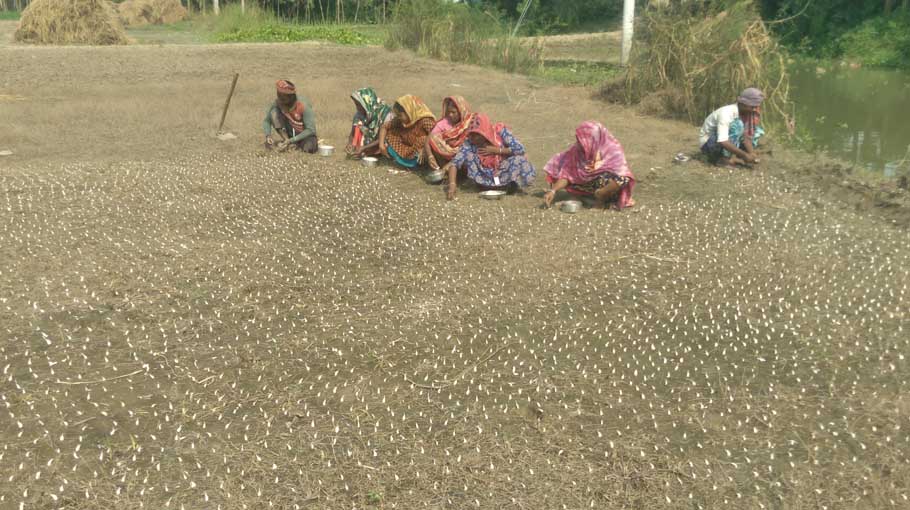Huge garlic cultivation likely in Chalanbeel, farmers busy in fields


Garlic has been cultivated for the last 25 years in a vast area of 800 square miles of Chalanbeel in Pabna-Natore-Sirajganj region. In recent years, garlic was known as "white gold" in the area. This year, farmers are hoping to get bumper yield of garlic in this region.
Garlic has been cultivated in about three thousand hectares of land in Chatmohar, Bhangura, Faridpur, Tarash, Raiganj, Baraigram, Gurudaspur and Singra upazilas of Chalanbil for the last few decades. As the price of garlic is reduced, officials stated that the garlic cultivation will be less than the previous year. It is estimated that 2.5 lakh tonnes of garlic may be produced in Chalanbilan this season.
As water has gone down from the beel area and Aman paddy harvesting has yet to be started. Farmers are preparing themselves to plant garlic in those lands and for this reason, they are preparing seeds. After harvesting the aman paddy, the owners will crear the land by cutting the stubble (part of the straw). This clean soft soil will be covered with garlic.
According to the findings, the target for garlic cultivation this year has been set at 6,100 hectares in Chatmohar, 10,740 hectares in Baraigram, 8,300 hectares in Gurudaspur and 1,460 hectares in Singra. About twenty-five years ago, farmers in the border areas of Baraigram and Gurudaspur upazilas of Natore started cultivating garlic on their own initiative. Usually before winter, garlic seed is planted in the soft soil of the land. This method does not require any extra fertilizer for garlic. Weeds grow less in the land while garlic is being cultivated. The cost of production is low whereas the yield is high. Garlic can be harvested within 120 days from planting. Garlic is usually extracted at the beginning of spring.
Read More: Fishing continues unabated in Chalanbeel
Farmers in the area said that garlic is sold at Amritkunda Hat, Mirzapur Hat, Chaikola Hat in Chatmohar, Pabna, Lakshikal Bazar in Natore, Rayna, Bharat Hat, Moukhara Hat, Jalshuka Hat, Chanchkair Hat and other markets in Chalanbeel area. Numerous warehouses have been set up in these markets to buy and sell garlic. Sellers from many districts of the country including Dhaka, Chattogram, Sylhet buy garlic and supply it to different cities of the country as per the demand through warehouse keepers.
Enamul Haque, a garlic farmer from Ramnagar village in Bilchalan union of Chatmohar, said he cultivated garlic on two bighas of land last year. This time he is cultivating garlic in two bighas of land. To plant two bighas of land, it will take 8 mounds seeds which cost 10 thousand Tk. To spread the seed of garlic seed, one has to pay Tk 200 per maund, Tk 1,800 for planting. It will cost about Tk 81,000 including labor of Tk. 1,000 for plowing part of the paddy straw, Tk. 5,000 for irrigating three times, Tk. 3,000 for weeding twice, Tk.
If high yield is achieved is achieved, the yield per bigha will be up to 30-40 maunds. Last year, during the lifting season, the price was Tk 2,000 per maund for garlic, but later the price dropped sharply. At present good quality seed garlic is being sold for 12 to 15 hundred Tk. However, ordinary garlic is being sold at TK 800 to TK 1,000 per quintal. Those who cultivated garlic last year have suffered huge losses. He added, “The garlic market is not stable. In some years it becomes 6 thousand Tk and in some years it becomes 800 Tk. Those who cultivate other people's land on annual lease incur more losses if the price of garlic falls. Growing garlic is a lot like gambling. ”
Thousands of women agricultural workers work in planting, weeding and lifting garlic in Chalanbeel area. According to these women workers, the labor crisis in the Chalonbeel area is evident during the planting and harvesting of garlic. During this time, various activities including cutting paddy, planting winter crops, cutting paddy from the paddy field are carried out. During this time they plant garlic and work in the field for a few days while harvesting garlic and earn some extra money which helps in the family.
Ajufa Khatun, a female worker, said she had to get up at 4 am and go to the field by 6 am after finishing other work including cooking. If she works all day, she get paid 200 Tk. Male workers are paid four and a half to five hundred Tk for the same work. Women workers have been victims of wage inequality year after year.
Abdul Latif, acting deputy director of Pabna's agriculture department, said last year's production was this year's target. Garlic cultivation in Pabna has been targeted at 13,300 hectares. Last year, the average yield was 9.46 metric tons per hectare. If the price goes up, the farmer will benefit.



